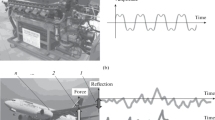Abstract
A numerical model for the split Hopkinson bar fly-away technique is presented to evaluate the performance of accelerometers measuring large amplitude pulses. Simulation results based on the numerical model indicate that the rise time of the incident stress pulse in the incident bar and the disk length are of appropriate lengths for the disk response to be accurately approximated as a rigid-body motion. Strain-time histories demonstrate that the incident strain pulse is non-dispersive. The rigid-body acceleration of the disk is derived from analytical models with stress at the incident bar/disk interface, incident strain-time data, and particle velocity on the free end of the disk calculated from numerical results. Thus, accelerations measured using the accelerometer and those derived from the models can be compared. These acceleration-time pulses show good agreement. The numerical model of the split Hopkinson bar fly-away technique can be used to calibrate high g accelerometers.
Similar content being viewed by others
References
P. Xu, J. Zu and J. B. Fan, Acceleration measurement of projectile high velocity penetrating concrete target and acceleration signal analysis, Journal of Measurement Science and Instrumentation, 1(1) (2010) 22–27.
M. J. Forrestal, T. C. Togami, W. E. Baker and D. J. Frew, Performance evaluation of accelerometers used for penetration experiments, Experimental Mechanics, 43(1) (2003) 90–96.
J. Dong, X. X. Li, Y. L. Wang, D. R. Lu and S. Ahat, Silicon micromachined high shock accelerometers with curvedsurface-application structure for over-range stop protection and free-mode-resonance depression, Journal of Micromechanics and Microengineering, 12(6) (2002) 742–746.
R. D. Sill, Testing techniques involved with the development of high shock acceleration sensors, Endevco Technical Paper TP 284, San Juan Capistrano, CA (1983).
R. D. Sill, Shock calibration of accelerometers at amplitudes to 100,000 g using Compression Waves, Endevco Technical Paper TP 283, San Juan Capistrano, CA (1983).
V. I. Bateman, W. B. Leisher, F. A. Brown and N. T. Davie, Calibration of a Hopkinson bar with a transfer standard, Shock and Vibration, 1(1993) 145–152.
Z. C. Togami, W. E. Baker and M. J. Forrestal, A split Hopkinson bar technique to evaluate the performance of accelerometers, Journal of Applied Mechanics, 63(1996) 353–356.
Z. C. Togami, E. A. Brown, M. J. Forrestal and W. E. Baker, Performance evaluation of accelerometers to 200,000 g, Journal of Applied Mechanics, 65 (1998) 266–268.
Q. M. Li and H. Meng, About the dynamic strength enhancement of concrete-like materials in a split Hopkinson pressure bar test, International Journal of Solids and Structures, 40(2) (2003) 343–360.
H. Meng and Q. M. Li, Correction between the accuracy of a SHPB test and the stress uniformity based on numerical experiments, International Journal of Impact Engineering, 28(5) (2003) 537–555.
ABAQUS theory manual, version 6.7-1, Hibbitt, Karlson & Sorensen, Inc. (2007).
F. Grensing and D. Hashiguchi, Mechanical and thermal properties of aluminum-beryllium AM162, Materion Brush Beryllium & Composites Data Sheet, 14710 W Portage River South Rd, Elmore, OH 43416-9502.
J. C. Dodson, Lt. L. Watkins and J. R. Foley, Comparative analysis of triaxial shock accelerometer output, Proc. of the IMAC-XXVIII, Jacksonville, Florida, USA (2010) 1529–1536.
R. J. Wasley, K. G. Hoge and J. C. Cast, Combined strain gauge-quartz crystal instrumented Hopkinson split bar, Review of Scientific Instruments, 40 (1969) 889–894.
W. Chen, F. Lu and B. Zhou, A quartz-crystal-embedded split Hopkinson pressure bar for soft materials, Experimental Mechanics, 40(1) (2000) 1–6.
Endevco General Catalog, Piezoresistive accelerometer model 7270A, 60K, 30700 Rancho Viejo Road, San Juan Capistrano, CA 92675 (1997).
Q. F. Li, Research on the shock calibration with laserinterferometry for high g accelerometers, Zhongbei University Master Thesis (2008).
D. C. Robinson, M. R. Serbyn and B. E. Payne, A description of NBS calibration services in mechanical vibration and shock, NBS Technique Note 1232, National Bureau of Standards, Gaithersburg, MD (1987).
T. C. Togami, V. I. Bateman and F. A. Brown, Evaluation of a Hopkinson bar fly-away technique for high amplitude shock accelerometer calibration, Sandia National Laboratories Report, SAND98-1444C (1998).
Author information
Authors and Affiliations
Corresponding author
Additional information
Recommended by Associate Editor Sung Hoon Ahn
Yubin Lu: is an associate researcher at the Southwest University of Science and Technology (China), member of the International Association of Protective Structures. His research interest is the dynamic behavior of materials and structures.
Rights and permissions
About this article
Cite this article
Lu, Y., Cheng, Y. & Sun, Y. Performance evaluation of high g accelerometers. J Mech Sci Technol 27, 3357–3362 (2013). https://doi.org/10.1007/s12206-013-0857-5
Received:
Revised:
Accepted:
Published:
Issue Date:
DOI: https://doi.org/10.1007/s12206-013-0857-5




